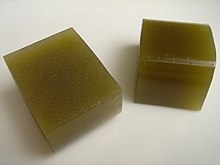
Back Agar-agar Afrikaans أغار Arabic Aqar Azerbaijani Агар (прадукт) Byelorussian Агар-агар Bulgarian অ্যাগার Bengali/Bangla Agar-agar Catalan Agar-agar CRH Agar Czech Agar Danish


Agar (/ˈeɪɡɑːr/ or /ˈɑːɡər/), or agar-agar, is a jelly-like substance consisting of polysaccharides obtained from the cell walls of some species of red algae, primarily from "ogonori" (Gracilaria) and "tengusa" (Gelidiaceae).[1][2] As found in nature, agar is a mixture of two components, the linear polysaccharide agarose and a heterogeneous mixture of smaller molecules called agaropectin.[3] It forms the supporting structure in the cell walls of certain species of algae and is released on boiling. These algae are known as agarophytes, belonging to the Rhodophyta (red algae) phylum.[4][5] The processing of food-grade agar removes the agaropectin, and the commercial product is essentially pure agarose.
Agar has been used as an ingredient in desserts throughout Asia and also as a solid substrate to contain culture media for microbiological work. Agar can be used as a laxative; an appetite suppressant; a vegan substitute for gelatin; a thickener for soups; in fruit preserves, ice cream, and other desserts; as a clarifying agent in brewing; and for sizing paper and fabrics.[6][7]
- ^ Shimamura, Natsu (August 4, 2010). "Agar". The Tokyo Foundation. Retrieved 19 December 2016.
- ^ Oxford Dictionary of English (2nd ed.). 2005.
- ^ Williams, Peter W.; Phillips, Glyn O. (2000). "2: Agar". Handbook of hydrocolloids. Cambridge, England: Woodhead. p. 91. ISBN 1-85573-501-6.
Agar is made from seaweed and it is attracted to bacteria.
- ^ Balfour, Edward Green (1871). "agar". Cyclopædia of India and of eastern and southern Asia, commercial, industrial and scientific: products of the mineral, vegetable and animal kingdoms, useful arts and manufactures. Scottish and Adelphi Presses. p. 50.
- ^ Davidson, Alan (2006). The Oxford Companion to Food. Oxford University Press. ISBN 978-0-19-280681-9.
- ^ "Showing Food Agar". The Metabolomics Innovation Centre (TMIC). Archived from the original on 2021-05-09.
- ^ Edward Green Balfour (1857). Cyclopaedia of India and of Eastern and Southern Asia, commercial, industrial and scientific... printed at the Scottish Press. p. 13.